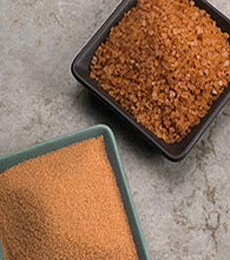TIP OF THE DAY: Why Use Sea Salt?
|
Bid adieu to one of food’s icons, the Morton Salt Girl, whose highly refined, iodized salt is too salty for table use. Instead, accent your food with the far more vivid flavors of sea salts.
Sea salts are dehydrated from ocean water. They are not refined like table salts, so contain traces of calcium, iron, magnesium, manganese, potassium, zinc and natural iodine present in the waters from which they were harvested. These individual ocean “terroirs” (tur-WAH) give each sea salt its own unique flavor and appearance. This makes them more healthful as well as tastier. And many sea salts are beautiful, sprinkled atop foods for visual as well as flavor notes. (Garnishing salts cost more. Inexpensive sea salts are available for cooking—we use La Baleine.) Imported from all over the world, there are scores of different sea salts available in the U.S. Each has its own flavor and beauty. |
 Alaea, Hawaiian sea salt, in fine and coarse grinds. Photo courtesy Saltworks.us, which sells beautiful sea salts from all over the world. |
|
|
Some of our favorites are elegant grey Celtic salt from France; coral-hued alaea, a volcanic Hawaiian sea salt (with a mellower flavor than other sea salts); the crunchy crystals of Angsley salt from Wales; the pyramid-shaped crystals of Maldon salt from England; and Himalayan pink salt. For table use, sea salt grains are generally too large for most salt shakers. Just treat yourself to a salt mill. This stylish salt mill from Oxo Good Grips also has a matching pepper mill. Many of us were taught in school that it is important to consume iodized table salt to prevent the development of goiter, an enlargement of the thyroid gland caused by iodine deficiency American salt manufacturers began iodizing salt in the 1920s, in cooperation with the government, after people in some parts of the country were found to be suffering from goiter due to an absence of iodine in their diets. Humans require fewer than 225 micrograms of iodine a day. Seafood, cruciferous vegetables*, and sea salt contain iodine naturally and iodized salt is unnecessary if there are sufficient quantities of these items in one’s diet. *The cruciferous vegetable group includes bok choy, broccoli, brussels sprouts, cauliflower, cabbage, kale, kohlrabi, mustard greens and turnips, among other veggies. HOW MANY TYPES OF SALT HAVE YOU HAD? Take a look at all the lovely salts in our Salt Glossary. You’ll be inspired to run out (or click) for some. SPECTACULAR SALT BOOKS Love food? Love history? One of our favorite food books is Mark Kurlansky’s Salt: A World History. Mark Bittman fans should also pick up a copy of Salted: A Manifesto on the World’s Most Essential Mineral, with 50 Bittman recipes that showcase the different aspects of salt.
|
||


